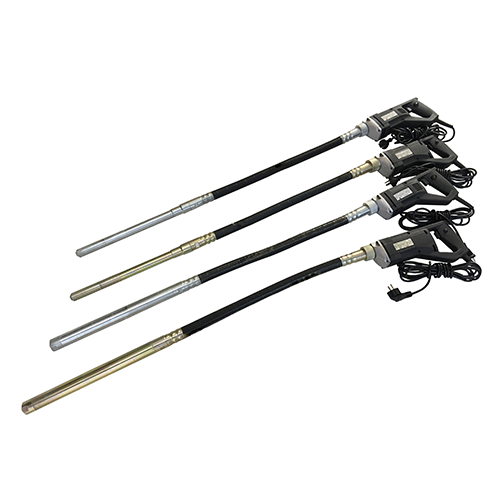Why Is the Internal Concrete Vibrator an Essential Tool for Achieving High-Quality Concrete Pouring?
2025-02-26
When it comes to achieving the perfect concrete pour, many factors contribute to the overall success of the project. One such factor that plays a crucial role in ensuring that concrete is properly mixed, poured, and compacted is the internal concrete vibrator. But why is this tool so essential for high-quality concrete pouring? How does it work, and what makes it so important in the construction industry? Let’s dive deeper into the significance of the internal concrete vibrator and why it is considered a must-have tool for many construction projects.
What is an Internal Concrete Vibrator?
An internal concrete vibrator, often referred to as a poker vibrator, is a specialized tool used to remove air bubbles and improve the density of freshly poured concrete. The device consists of a motor, a flexible shaft, and a vibrator head (often shaped like a poker or rod) that is inserted directly into the freshly poured concrete. The vibrator works by vibrating at high speeds, causing the concrete to flow and settle more effectively, reducing the chances of air pockets or voids forming.
Internal concrete vibrators are widely used in both small and large construction projects, from residential buildings to high-rise structures. They are especially beneficial when working with thicker concrete mixes or larger pours, where the likelihood of air pockets is higher.
Why is an Internal Concrete Vibrator Important in Concrete Pouring?
1. Improves Concrete Compaction
One of the main functions of the internal concrete vibrator is to improve the compaction of the concrete. Compaction refers to the process of ensuring that the concrete mix is properly packed together without any air pockets. When concrete is poured, it can trap air within its mixture, creating voids that weaken the structure. By using the internal vibrator, the vibrations help to eliminate these trapped air pockets, allowing the concrete to settle and fill every corner of the mold or formwork.
Proper compaction not only strengthens the concrete but also ensures that it has a smooth and consistent finish, which is crucial for the durability of the structure.
2. Enhances Concrete Workability
Freshly mixed concrete can sometimes be too thick or stiff, making it difficult to work with or mold. The internal concrete vibrator helps in improving the workability of the concrete by agitating it and making it easier to spread or shape. This is particularly important for complex or intricate forms where the concrete needs to flow easily to fill every detail.
The vibrator's action makes it easier to control the flow of concrete, resulting in a smoother, more uniform pour, which leads to higher-quality finishes. This is especially critical when pouring concrete in confined spaces or complex molds where accurate placement is essential.
3. Prevents Segregation of Materials
In concrete, segregation refers to the separation of the different materials within the mix, such as the cement, aggregates, and water. When segregation occurs, it can lead to an uneven mix, causing weak spots in the final product. The internal concrete vibrator helps to prevent segregation by maintaining the homogeneity of the concrete during the pouring process.
By vibrating the mixture, the vibrator ensures that the aggregates and cement remain evenly distributed, resulting in a more uniform and structurally sound final product.
4. Increases Concrete Density
For certain projects, such as those that require high-strength concrete or those exposed to harsh weather conditions, it’s crucial to ensure the concrete is dense and durable. The internal concrete vibrator helps achieve this by promoting the proper compaction of the concrete, leading to a denser mix with fewer air pockets.
A denser concrete mix is more resistant to cracking, water penetration, and other forms of wear and tear. This makes it especially important in construction projects that involve heavy-duty infrastructure, such as bridges, highways, or industrial floors.
5. Saves Time and Labor Costs
Using an internal concrete vibrator can significantly reduce the amount of time and labor required during the pouring process. By efficiently compacting and settling the concrete, the vibrator helps to eliminate the need for manual work, which can be labor-intensive and time-consuming. The faster the concrete is poured and compacted, the less time is spent on the overall project, which can result in significant cost savings.
Additionally, the use of the vibrator helps to avoid common issues like uneven curing or the need for additional work to address defects caused by improper compaction. This leads to fewer delays and a more efficient construction process.
What Are the Key Features of an Internal Concrete Vibrator?
1. Vibration Frequency and Power
The effectiveness of an internal concrete vibrator largely depends on its vibration frequency and power. A high-frequency vibrator (typically between 12,000 to 15,000 vibrations per minute) is able to efficiently compact the concrete and remove air pockets. The power of the vibrator should match the scale of the project to ensure it provides the necessary force to penetrate and vibrate through the concrete mix.
2. Flexible Shaft Length
The length of the flexible shaft is another important factor to consider when choosing an internal vibrator. The shaft length determines how deep the vibrator can be inserted into the concrete. A longer shaft allows the vibrator to reach deeper pours or thicker concrete layers, while a shorter shaft is more suitable for smaller-scale projects.
3. Vibrator Head Size and Shape
The size and shape of the vibrator head (or poker) also affect how effectively the concrete is compacted. Smaller heads are ideal for compacting smaller pours, while larger heads are better suited for larger-scale projects or deep pours. The shape of the head can also influence how well the vibrator reaches every corner of the formwork.
4. Portability and Ease of Use
Internal concrete vibrators come in both portable and more stationary versions, depending on the scale of the project. Portable models, which are typically hand-held, are perfect for smaller jobs and for working in tight spaces. Larger, more industrial-grade models may be mounted on a trolley for easier transport around the site. Ease of use is critical, as the vibrator should be easy to operate, especially when working on large or complex pours.
Applications of Internal Concrete Vibrators
Internal concrete vibrators are widely used in various construction applications, including:
- Building Foundations: Ensuring that concrete foundations are properly compacted to avoid air pockets and increase strength.
- Columns and Beams: For ensuring proper compaction in vertical forms, reducing voids and improving structural integrity.
- Pavement Construction: Used to ensure the smooth and dense pouring of concrete on roads and pavement.
- Bridge Decks: Ensuring dense, durable concrete in bridge decks that will be exposed to heavy loads and environmental stress.
Conclusion
The internal concrete vibrator is an indispensable tool for any construction project that involves pouring concrete. Its ability to improve compaction, enhance workability, prevent segregation, and increase density makes it essential for achieving high-quality, durable concrete structures. Whether you’re building residential homes, highways, or bridges, the internal concrete vibrator ensures that your concrete mix is well-compacted, resulting in stronger and longer-lasting structures. Despite advancements in construction technology, this humble tool continues to be a vital component for modern concrete pouring.



